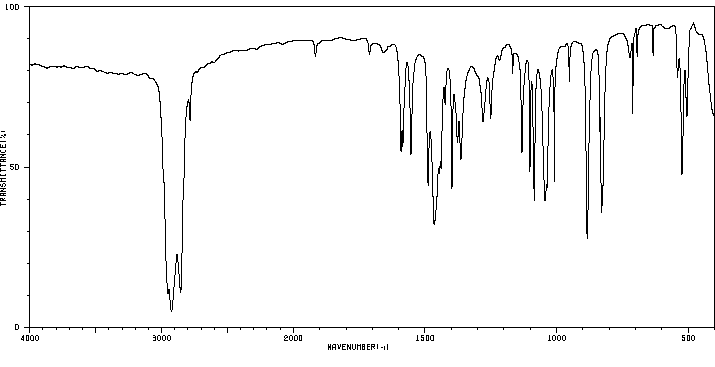(E)-p-chlorobenzaldehyde N,N-dimethylhydrazone | 138616-25-8
中文名称
——
中文别名
——
英文名称
(E)-p-chlorobenzaldehyde N,N-dimethylhydrazone
英文别名
p-Chlorobenzaldehyde dimethylhydrazone;N-[(E)-(4-chlorophenyl)methylideneamino]-N-methylmethanamine
CAS
138616-25-8
化学式
C9H11ClN2
mdl
——
分子量
182.653
InChiKey
JWRGEPOIPOSDQN-YRNVUSSQSA-N
BEILSTEIN
——
EINECS
——
-
物化性质
-
计算性质
-
ADMET
-
安全信息
-
SDS
-
制备方法与用途
-
上下游信息
-
文献信息
-
表征谱图
-
同类化合物
-
相关功能分类
-
相关结构分类
计算性质
-
辛醇/水分配系数(LogP):3.1
-
重原子数:12
-
可旋转键数:2
-
环数:1.0
-
sp3杂化的碳原子比例:0.22
-
拓扑面积:15.6
-
氢给体数:0
-
氢受体数:2
反应信息
-
作为反应物:描述:(E)-p-chlorobenzaldehyde N,N-dimethylhydrazone 在 吡啶 、 盐酸 作用下, 以 乙腈 为溶剂, 反应 72.0h, 生成 1-(4-chlorophenyl)-3,3,3-trifluoropropan-1-one参考文献:名称:Convenient Synthesis of 1,1,1-Trifluoro-4,5-diaza-2,4-alkadienes and 1-Aryl-3,3,3- trifluoro-1-propanones摘要:通过与过量的三氟乙酸酐在吡啶中反应,由芳烃甲醛二甲基腙1或其三氟乙酰化衍生物2以良好的产率合成了几种3-芳基-1,1,1-三氟-4,5-二氮杂-2,4-链二烯3。 3的酸水解以高产率得到1-芳基-3,3,3-三氟-1-丙酮4。DOI:10.1055/s-1989-27144
-
作为产物:参考文献:名称:(E)-到(Z)-N,N-二甲基hydr的光异构化和热还原摘要:脂肪醛N,N-二甲基hydr的E-异构体在UV(254 nm)辐射下经历竞争性E - Z异构化和光解成腈。所述ž - ë异构体混合物,这导致热恢复到更稳定的È异构体和下短的辐照时间的光异构化/热循环逆转可以是可逆的。三甲基乙醛N,N-二甲基hydr经历相似的反应(排除其他类型的异构化的干预),RCH的热Z → E反应速率N–NMe 2的顺序为R = Bu t > Et> Me。根据the的构象和E - Z异构化的机理来考虑结果。DOI:10.1039/p29910001649
文献信息
-
Palladium-Catalyzed C(sp<sup>2</sup> )−H Alkylation of Aldehyde-Derived Hydrazones with Functionalized Difluoromethyl Bromides作者:Alexis Prieto、Romain Melot、Didier Bouyssi、Nuno MonteiroDOI:10.1002/anie.201510334日期:2016.1.26A palladium‐catalyzed C(sp2)−H difluoromethylation of aldehyde‐derived hydrazones using bromodifluoromethylated compounds to afford the corresponding functionalized difluoromethylketone hydrazones has been established. It is proposed that a radical/SET mechanism proceeding via a difluoroalkyl radical may be involved in the catalytic cycle. Applications of the methodology to the synthesis of α,α‐difluoro‐β‐ketoesters
-
Weber, Lutz; Muehlstaedt, Manfred, Zeitschrift fur Chemie, 1988, vol. 28, # 1, p. 26 - 27作者:Weber, Lutz、Muehlstaedt, ManfredDOI:——日期:——
-
Elimination reactions of hydrazonium salts: experimental and theoretical evidence for a large stereoelectronic effect of nitrogen作者:Nguyen Minh Tho、Leo F. Clarke、Anthony F. HegartyDOI:10.1021/jo00312a026日期:1990.12
-
Direct synthesis of dithioketals from N,N-dialkylhydrazones作者:Elena Díez、Ana M López、Carmen Pareja、Eloísa Martín、Rosario Fernández、JoséM LassalettaDOI:10.1016/s0040-4039(98)01728-6日期:1998.10Direct dithioketalisation of N,N-dialkylhydrazones promoted by BF3. Et2O or p-TsOH and 1,2-ethanedithiol in dry medium affords the corresponding dithiolanes in nearly quantitative yields. A variety of hydrazones derived from several kinds of aldehydes (aliphatic, aromatic, and alpha,beta-unsaturated) and hydrazines [N, N-dimethylhydrazine, 1-aminopyrrolidine, and (S)-1-amino-2- (methoxymethyl)pyrrolidine (SAMP)] were reacted, indicating the generality of the method. The reaction was demonstrated to proceed without racemization of a particularly sensitive chiral substrate. (C) 1998 Elsevier Science Ltd. All rights reserved.
-
Syntheses and structures of exo- and endo-cyclopalladated phenylhydrazones作者:Jaume Granell、Rosa Moragas、Joaquim Sales、Mercè Font-Bardía、Xavier SolansDOI:10.1039/dt9930001237日期:——The reaction of substituted benzylidenephenylhydrazones with palladium(II) salts has been found to give exo in preference to endo five-membered metallacycles. The endo derivatives can only be obtained if the hydrazone phenyl ring contains chlorine substituents in the ortho or meta positions. The tendency of these hydrazone ligands to give exo derivatives, in contrast to the results found with similar N-benzylideneamines which favour the formation of endo-palladocycles, can be explained by the planarity of the hydrazone ligands, which favours the interaction of the C-H bond of the hydrazone phenyl ring with the palladium. Moreover, the aminic nitrogen atom activates this phenyl ring to electrophilic attack. The crystal structures of two of the metallacycles have been determined.
表征谱图
-
氢谱1HNMR
-
质谱MS
-
碳谱13CNMR
-
红外IR
-
拉曼Raman
-
峰位数据
-
峰位匹配
-
表征信息
同类化合物
(βS)-β-氨基-4-(4-羟基苯氧基)-3,5-二碘苯甲丙醇
(S,S)-邻甲苯基-DIPAMP
(S)-(-)-7'-〔4(S)-(苄基)恶唑-2-基]-7-二(3,5-二-叔丁基苯基)膦基-2,2',3,3'-四氢-1,1-螺二氢茚
(S)-盐酸沙丁胺醇
(S)-3-(叔丁基)-4-(2,6-二甲氧基苯基)-2,3-二氢苯并[d][1,3]氧磷杂环戊二烯
(S)-2,2'-双[双(3,5-三氟甲基苯基)膦基]-4,4',6,6'-四甲氧基联苯
(S)-1-[3,5-双(三氟甲基)苯基]-3-[1-(二甲基氨基)-3-甲基丁烷-2-基]硫脲
(R)富马酸托特罗定
(R)-(-)-盐酸尼古地平
(R)-(-)-4,12-双(二苯基膦基)[2.2]对环芳烷(1,5环辛二烯)铑(I)四氟硼酸盐
(R)-(+)-7-双(3,5-二叔丁基苯基)膦基7''-[((6-甲基吡啶-2-基甲基)氨基]-2,2'',3,3''-四氢-1,1''-螺双茚满
(R)-(+)-7-双(3,5-二叔丁基苯基)膦基7''-[(4-叔丁基吡啶-2-基甲基)氨基]-2,2'',3,3''-四氢-1,1''-螺双茚满
(R)-(+)-7-双(3,5-二叔丁基苯基)膦基7''-[(3-甲基吡啶-2-基甲基)氨基]-2,2'',3,3''-四氢-1,1''-螺双茚满
(R)-(+)-4,7-双(3,5-二-叔丁基苯基)膦基-7“-[(吡啶-2-基甲基)氨基]-2,2”,3,3'-四氢1,1'-螺二茚满
(R)-3-(叔丁基)-4-(2,6-二苯氧基苯基)-2,3-二氢苯并[d][1,3]氧杂磷杂环戊烯
(R)-2-[((二苯基膦基)甲基]吡咯烷
(R)-1-[3,5-双(三氟甲基)苯基]-3-[1-(二甲基氨基)-3-甲基丁烷-2-基]硫脲
(N-(4-甲氧基苯基)-N-甲基-3-(1-哌啶基)丙-2-烯酰胺)
(5-溴-2-羟基苯基)-4-氯苯甲酮
(5-溴-2-氯苯基)(4-羟基苯基)甲酮
(5-氧代-3-苯基-2,5-二氢-1,2,3,4-oxatriazol-3-鎓)
(4S,5R)-4-甲基-5-苯基-1,2,3-氧代噻唑烷-2,2-二氧化物-3-羧酸叔丁酯
(4S,4''S)-2,2''-亚环戊基双[4,5-二氢-4-(苯甲基)恶唑]
(4-溴苯基)-[2-氟-4-[6-[甲基(丙-2-烯基)氨基]己氧基]苯基]甲酮
(4-丁氧基苯甲基)三苯基溴化磷
(3aR,8aR)-(-)-4,4,8,8-四(3,5-二甲基苯基)四氢-2,2-二甲基-6-苯基-1,3-二氧戊环[4,5-e]二恶唑磷
(3aR,6aS)-5-氧代六氢环戊基[c]吡咯-2(1H)-羧酸酯
(2Z)-3-[[(4-氯苯基)氨基]-2-氰基丙烯酸乙酯
(2S,3S,5S)-5-(叔丁氧基甲酰氨基)-2-(N-5-噻唑基-甲氧羰基)氨基-1,6-二苯基-3-羟基己烷
(2S,2''S,3S,3''S)-3,3''-二叔丁基-4,4''-双(2,6-二甲氧基苯基)-2,2'',3,3''-四氢-2,2''-联苯并[d][1,3]氧杂磷杂戊环
(2S)-(-)-2-{[[[[3,5-双(氟代甲基)苯基]氨基]硫代甲基]氨基}-N-(二苯基甲基)-N,3,3-三甲基丁酰胺
(2S)-2-[[[[[((1S,2S)-2-氨基环己基]氨基]硫代甲基]氨基]-N-(二苯甲基)-N,3,3-三甲基丁酰胺
(2S)-2-[[[[[[((1R,2R)-2-氨基环己基]氨基]硫代甲基]氨基]-N-(二苯甲基)-N,3,3-三甲基丁酰胺
(2-硝基苯基)磷酸三酰胺
(2,6-二氯苯基)乙酰氯
(2,3-二甲氧基-5-甲基苯基)硼酸
(1S,2S,3S,5S)-5-叠氮基-3-(苯基甲氧基)-2-[(苯基甲氧基)甲基]环戊醇
(1S,2S,3R,5R)-2-(苄氧基)甲基-6-氧杂双环[3.1.0]己-3-醇
(1-(4-氟苯基)环丙基)甲胺盐酸盐
(1-(3-溴苯基)环丁基)甲胺盐酸盐
(1-(2-氯苯基)环丁基)甲胺盐酸盐
(1-(2-氟苯基)环丙基)甲胺盐酸盐
(1-(2,6-二氟苯基)环丙基)甲胺盐酸盐
(-)-去甲基西布曲明
龙蒿油
龙胆酸钠
龙胆酸叔丁酯
龙胆酸
龙胆紫-d6
龙胆紫








